Titanium Dioxide as a Catalyst in Biodiesel Production
Abstract
:1. Introduction
2. Titania-Based Catalysts in Transesterification Reaction
2.1. Sulfated TiO2
2.1.1. SO42−/TiO2
2.1.2. SO42−/TiO2-ZrO2
2.1.3. SO42−/TiO2-SiO2
2.1.4. SO42−/TiO2/La3+
2.1.5. SO42−/TiO2/Fe2O3
2.2. TiO2-Supported-ZnO4
2.3. TiO2-MgO
2.4. CaTiO3
2.5. K-Loading/TiO2
3. Titania-Based Catalysts in Continuous Flow Microreactors
4. Titania-Based Additives to Biodiesel
5. Conclusions
Author Contributions
Funding
Acknowledgments
Conflicts of Interest
References
- Thanh, L.T.; Okitsu, K.; Van Boi, L. Maeda, Y. Catalytic Technologies for Biodiesel Fuel Production and Utilization of Glycerol: A Review. Catalysts 2012, 2, 191–222. [Google Scholar] [CrossRef]
- Glisic, S.B.; Pajnik, J.M.; Orlović, A.M. Process and techno-economic analysis of green diesel production from waste vegetable oil and the comparison with ester type biodiesel production. Appl. Energy 2016, 170, 176–185. [Google Scholar] [CrossRef]
- Bobadilla Corral, M.; Lostado Lorza, R.; Escribano García, R.; Somovilla Gómez, F.; Vergara González, E.P. An Improvement in Biodiesel Production from Waste Cooking Oil by Applying Thought Multi-Response Surface Methodology Using Desirability Functions. Energies 2017, 10, 130. [Google Scholar] [CrossRef]
- Bavykin, D.V.; Walsh, F.C. Titanate and Titania Nanotubes: Synthesis. RSC Nanosci. Nanotechnol. 2009. [Google Scholar] [CrossRef]
- Bartl, M.H.; Boettcher, S.W.; Frindell, K.L.; Stucky, G.D. Molecular assembly of function in titania-based composite material system. Acc. Chem. Res. 2005, 38, 263–271. [Google Scholar] [CrossRef] [PubMed]
- Linsebigler, A.L.; Lu, G.; Yates, J.T. Photocatalysis on TiO2 Surfaces: Principles, Mechanisms, and Selected Results. Chem. Rev. 1995, 95, 735–758. [Google Scholar] [CrossRef]
- Siling, M.I.; Laricheva, T.N. Titanium compounds as catalysts for esterification and transesterification. Russ. Chem. Rev. 1996, 65, 279–286. [Google Scholar] [CrossRef]
- Carlucci, C.; Xu, H.; Scremin, B.F.; Giannini, C.; Sibillano, T.; Carlino, E.; Videtta, V.; Gigli, G.; Ciccarella, G. Controllable One-Pot Synthesis of Anatase TiO2 Nanorods with the Microwave-Solvothermal Method. Sci. Adv. Mater. 2014, 6, 1668–1675. [Google Scholar] [CrossRef]
- Bagheri, S.; Julkapli, N.M.; Hamid, S.B.A. Titanium Dioxide as a Catalyst Support in Heterogeneous Catalysis. Sci. World J. 2014, 2014, 727496. [Google Scholar] [CrossRef]
- Noda, L.K.; de Almeida, R.M.; Probst, L.F.D.; Gonçalves, N.S. Characterization of sulfated TiO2 prepared by the sol–gel method and its catalytic activity in the n-hexane isomerization reaction. J. Mol. Catal. A Chem. 2005, 225, 39–46. [Google Scholar] [CrossRef]
- Refaat, A. Biodiesel production using solid metal oxide catalysts. Int. J. Environ. Sci. Technol. 2011, 8, 203–221. [Google Scholar] [CrossRef]
- Noda, L.K.; de Almeida, R.M.; Gonçalves, N.S.; Probst, L.F.D.; Sala, O. TiO2 with a high sulfate content -thermogravimetric analysis, determination of acid sites by infrared spectroscopy and catalytic activity. Catal. Today 2003, 85, 69–74. [Google Scholar] [CrossRef]
- Cui, H.; Dwight, K.; Soled, S.; Wold, A. Surface Acidity and Photocatalytic Activity of Nb2O5/TiO2 Photocatalysts. J. Solid State Chem. 1995, 115, 187–191. [Google Scholar] [CrossRef]
- Li, G. Surface modification and charachterizations of TiO2 nanoparticle. Surf. Rev. Lett. 2009, 16, 149–151. [Google Scholar] [CrossRef]
- Gardy, J.; Hassanpour, A.; Laia, X.; Ahmed, M.H. Synthesis of Ti(SO4)O solid acid nano-catalyst and its application for biodiesel production from used cooking oil. Appl. Catal. A Gen. 2016, 527, 81–95. [Google Scholar] [CrossRef]
- Gardy, J.; Hassanpour, A.; Laia, X.; Ahmed, M.H.; Rehan, M. Biodiesel production from used cooking oil using a novel surface functionalised TiO2 nano-catalyst. Appl. Catal. B Environ. 2017, 207, 297–310. [Google Scholar] [CrossRef]
- Zhao, H.; Jiang, P.; Dong, Y.; Huang, M.; Liu, B. A high-surface-area mesoporous sulfated nano-titania solid superacid catalyst with exposed (101) facets for esterification: Facile preparation and catalytic performance. New J. Chem. 2014, 38, 4541–4548. [Google Scholar] [CrossRef]
- Ropero-Vega, J.L.; Aldana-Péreza, A.; Gómez, R.; Nino-Gómez, M.E. Sulfated titania [TiO2/SO42−]: A very active solid acid catalyst for the esterification of free fatty acids with ethanol. Appl. Catal. A Gen. 2010, 379, 24–29. [Google Scholar] [CrossRef]
- Li, X.; Huang, W. Synthesis of Biodiesel from Rap Oil over Sulfated Titania-based Solid Superacid Catalysts. Energy Sources Part A 2009, 31, 1666–1672. [Google Scholar] [CrossRef]
- de Almeida, R.M.; Noda, L.K.; Gonçalves, N.S.; Meneghetti, S.M.P.; Meneghetti, M.R. Transesterification reaction of vegetable oils, using superacid solfate TiO2-base catalysts. Appl. Catal. A Gen. 2008, 347, 100–105. [Google Scholar] [CrossRef]
- Chen, H.; Peng, B.; Wang, D.; Wang, J. Biodiesel production by the transesterification of cottonseed oil by solid acid catalysts. Front. Chem. Eng. China 2007, 1, 11–15. [Google Scholar] [CrossRef]
- Oprescu, E.E.; Velea, S.; Doncea, S.; Radu, A.; Stepan, E.; Bolocan, I. Biodiesel from Algae Oil with High Free Fatty Acid over Amphiphilic Solid Acid Catalyst. Chem. Eng. Trans. 2015, 43, 595–600. [Google Scholar] [CrossRef]
- Boffito, D.C.; Crocellà, V.; Pirola, C.; Neppolian, B.; Cerrato, G.; Ashokkumar, M.; Bianchi, C.L. Ultrasonic enhancement of the acidity, surface area and free fatty acids esterification catalytic activity of sulfated ZrO2-TiO2 systems. J. Catal. 2013, 297, 17–26. [Google Scholar] [CrossRef]
- Peng, B.-X.; Shu, Q.; Wang, J.-F.; Wang, G.-R.; Wang, D.-Z.; Han, M.-H. Biodiesel production from waste oil feedstocks by solid acid catalysis. Process. Saf. Environ. Prot. 2008, 86, 441–447. [Google Scholar] [CrossRef]
- Shao, G.N.; Sheikh, R.; Hilonga, A.; Lee, J.E.; Park, Y.-H.; Kim, H.T. Biodiesel production by sulfated mesoporous titania-silica catalysts synthesized by the sol–gel process from less expensive precursors. Chem. Eng. J. 2013, 215–216, 600–607. [Google Scholar] [CrossRef]
- Embong, N.H.; Maniam, G.P.; Rahim, M.H.A. Biodiesel Preparation from Decanter Cake with Solid Acid Catalyst. Int. J. Chem. Environ. Eng. 2014, 5, 294–296. [Google Scholar]
- Wang, K.; Jiang, J.; Si, Z.; Liang, X. Biodiesel production from waste cooking oil catalyzed by solid acid SO42−/TiO2/La3+. J. Renew. Sustain. Energy 2013, 5, 052001. [Google Scholar] [CrossRef]
- Li, Y.; Zhang, X.-D.; Sun, L.; Zhang, J.; Xu, H.-P. Fatty acid methyl ester synthesis catalyzed by solid superacid catalyst SO42−/ZrO2-TiO2/La3+. Appl. Energy 2010, 87, 156–159. [Google Scholar] [CrossRef]
- Anuradha, S.; Raj, K.J.A.; Vijayaraghavan, V.R.; Viswanathan, B. Sulfated Fe2O3-TiO2 catalysed transesterification of soybean oil to biodiesel. Indian J. Chem. 2014, 53, 1493–1499. [Google Scholar]
- Emeji, I.C.; Afolabi, A.S.; Abdulkareem, A.S.; Kalala, J. Characterization and Kinetics of Biofuel Produced from Waste Cooking Oil. In Proceedings of the World Congress on Engineering and Computer Science, San Francisco, CA, USA, 21–23 October 2015; Volume II. [Google Scholar]
- Madhuvilakku, R.; Piraman, S. Biodiesel synthesis by TiO2-ZnO mixed oxide nanocatalyst catalyzed palm oil transesterification process. Bioresour. Technol. 2013, 150, 55–59. [Google Scholar] [CrossRef]
- Sithole, T.; Meijboom, R.; Jalama, K. Biodiesel Production from Waste Vegetable Oil over MgO/TiO2 catalyst. IJESIT 2013, 2, 189–194. [Google Scholar]
- Mguni, L.L.; Meijboom, R.; Jalama, K. Biodiesel Production over nano-MgO Supported on Titania. Int. J. Chem. Mol. Nuclear Mater. Metall. Eng. 2012, 6, 380–384. [Google Scholar]
- Wen, Z.; Yu, X.; Tu, S.-T.; Yan, J.; Dahlquist, E. Biodiesel production from waste cooking oil catalyzed by TiO2-MgO mixed oxides. Bioresour. Technol. 2010, 101, 9570–9576. [Google Scholar] [CrossRef] [PubMed]
- Kawashima, A.; Matsubara, K.; Honda, K. Development of heterogeneous base catalysts for biodiesel production. Bioresour. Technol. 2008, 99, 3439–3443. [Google Scholar] [CrossRef] [PubMed]
- Salinas, D.; Guerrero, S.; Araya, P. Transesterification of canola oil on potassium-supported TiO2 catalysts. Catal. Commun. 2010, 11, 773–777. [Google Scholar] [CrossRef]
- Salinas, D.; Araya, P.; Guerrero, S. Study of potassium-supported TiO2 catalysts for the production of biodiesel. Appl. Catal. B Environ. 2012, 117–118, 260–267. [Google Scholar] [CrossRef]
- Martínez-Klimova, E.; Hernández-Hipólito, P.; Klimova, T.E. Biodiesel Production with Nanotubular Sodium Titanate Doped with Potassium as a Catalyst. MRS Adv. 2016, 1, 415–420. [Google Scholar] [CrossRef]
- Colella, M.; Carlucci, C.; Luisi, R. Supported Catalysts for Continuous Flow Synthesis. Top. Curr. Chem. 2018, 376, 46. [Google Scholar] [CrossRef]
- Fanelli, F.; Parisi, G.; Degennaro, L.; Luisi, R. Contribution of microreactor technology and flow chemistry to the development of green and sustainable synthesis. Beilstein J. Org. Chem. 2017, 13, 520–542. [Google Scholar] [CrossRef] [Green Version]
- Degennaro, L.; Carlucci, C.; De Angelis, S.; Luisi, R. Flow Technology for Organometallic-Mediated Synthesis. J. Flow Chem. 2016, 6, 136–166. [Google Scholar] [CrossRef]
- Degennaro, L.; Fanelli, F.; Giovine, A.; Luisi, R. External trapping of halomethyllithium enabled by flow microreactors. Adv. Synth. Catal. 2014, 357, 21–27. [Google Scholar] [CrossRef]
- Tran, D.-T.; Chang, J.-S.; Lee, D.-J. Recent insights into continuous-flow biodiesel production via catalytic and non-catalytic transesterification processes. Appl. Energy 2017, 185, 376–409. [Google Scholar] [CrossRef]
- Tiwari, A.; Rajesh, V.M.; Yadav, S. Biodiesel production in micro-reactors: A review. Energy Sustain. Dev. 2018, 43, 143–161. [Google Scholar] [CrossRef]
- Khana, Y.; Marina, M.; Viinikainena, T.; Lehtonena, J.; Puurunena, R.L.; Karinena, R. Structured microreactor with gold and palladium on titania: Active, regenerable and durable catalyst coatings for the gas-phase partial oxidation of 1-butanol. Appl. Catal. A Gen. 2018, 562, 173–183. [Google Scholar] [CrossRef]
- Barot, S.; Bandyopadhyay, R.; Joshi, S.S. Catalytic Conversion of Jatropha Oil to Biofuel Over Titania, Zirconia, and Ceria Loaded Amorphous Alumino-Silicate Catalysts. Environ. Prog. Sustain. Energy 2017, 36, 749–757. [Google Scholar] [CrossRef]
- McNeff, C.V.; McNeff, L.C.; Yan, B.; Nowlan, D.T.; Rasmussen, M.; Gyberg, A.E.; Krohn, B.J.; Fedie, R.L.; Hoye, T.R. A continuous catalytic system for biodiesel production. Appl. Catal. A Gen. 2008, 343, 39–48. [Google Scholar] [CrossRef]
- Krohn, B.J.; McNeff, C.V.; Yan, B.; Nowlan, D. Production of algae-based biodiesel using the continuous catalytic Mcgyan® process. Bioresour. Technol. 2011, 102, 94–100. [Google Scholar] [CrossRef]
- Baroutian, S.; Aroua, M.K.; Raman, A.A.A.; Sulaiman, N.M.N. A packed bed membrane reactor for production of biodiesel using activated carbon supported catalyst. Bioresour. Technol. 2011, 102, 1095–1102. [Google Scholar] [CrossRef]
- Len, C.; Delbecq, F.; Cara Corpas, C.; Ruiz Ramos, E. Continuous Flow Conversion of Glycerol into Chemicals: An Overview. Synthesis 2018, 50, 723–741. [Google Scholar] [CrossRef]
- Bhanuchander, P.; Priya, S.S.; Kumar, V.P.; Hussain, S.; Pethane Rajan, N.; Bhargava, S.K.; Chary, K.V.R. Direct Hydrogenolysis of Glycerol to Biopropanols over Metal Phosphate Supported Platinum Catalysts. Catal. Lett. 2017, 147, 845–855. [Google Scholar] [CrossRef]
- Liebig, C.; Paul, S.; Katryniok, B.; Guillon, C.; Couturier, J.L.; Dubois, J.L.; Dumeignil, F.; Hoelderich, W.F. Glycerol conversion to acrylonitrile by consecutive dehydration over WO3/TiO2 and ammoxidation over Sb-(Fe,V)-O. Appl. Catal. B Environ. 2013, 132–133, 170–182. [Google Scholar] [CrossRef]
- Jeryrajkumar, L.; Anbarasu, G.; Elangovan, T. Effects on Nano Additives on Performance and Emission Characteristics of Calophyllim inophyllum Biodiesel. Int. J. ChemTech Res. 2016, 9, 210–219. [Google Scholar]
- Venu, H.; Madhavan, V. Effect of nano additives (titanium and zirconium oxides) and diethyl ether on biodiesel-ethanol fuelled CI engine. J. Mech. Sci. Technol. 2016, 30, 2361–2368. [Google Scholar] [CrossRef]
- D’Silva, R.; Vinoothan, K.; Binu, K.G.; Bhat, T.; Raju, K. Effect of Titanium Dioxide and Calcium Carbonate Nanoadditives on the Performance and Emission Characteristics of C.I. Engine. K. J. Mech. Sci. Autom. 2016, 6, 28–31. [Google Scholar] [CrossRef]
- Prabhu, L.; Satish Kumar, S.; Andrerson, A.; Rajan, K. Investigation on performance and emission analysis of TiO2 nanoparticle as an additive for biodiesel blends. J. Chem. Pharm. Sci. 2015, 7, 408–412. [Google Scholar]
- Fangsuwannarak, K.; Triratanasirichai, K. Improvements of Palm Biodiesel Properties by Using Nano-TiO2 Additive, Exhaust emission and Engine Performance. Rom. Rev. Precis. Mech. Opt. Mechatron. 2013, 43, 111–118. [Google Scholar]
- Naveen, P.; Rajashekhar, C.R.; Umashankar, C.; Rajashekhar Kiragi, V. Effect of Titanium Oxide Coating on Performance Characteristics of Bio-Diesel (Honge) Fuelled C. I. Engine. IJMER 2012, 2, 2825–2828. [Google Scholar]
- Ravikumar, V.; Senthilkumar, D. Reduction of NOx emission on NiCrAl-Titanium Oxide coated direct injection diesel engine fuelled with radish (Raphanus sativus) biodiesel. J. Renew. Sustain. Energy 2013, 5, 063121. [Google Scholar] [CrossRef]
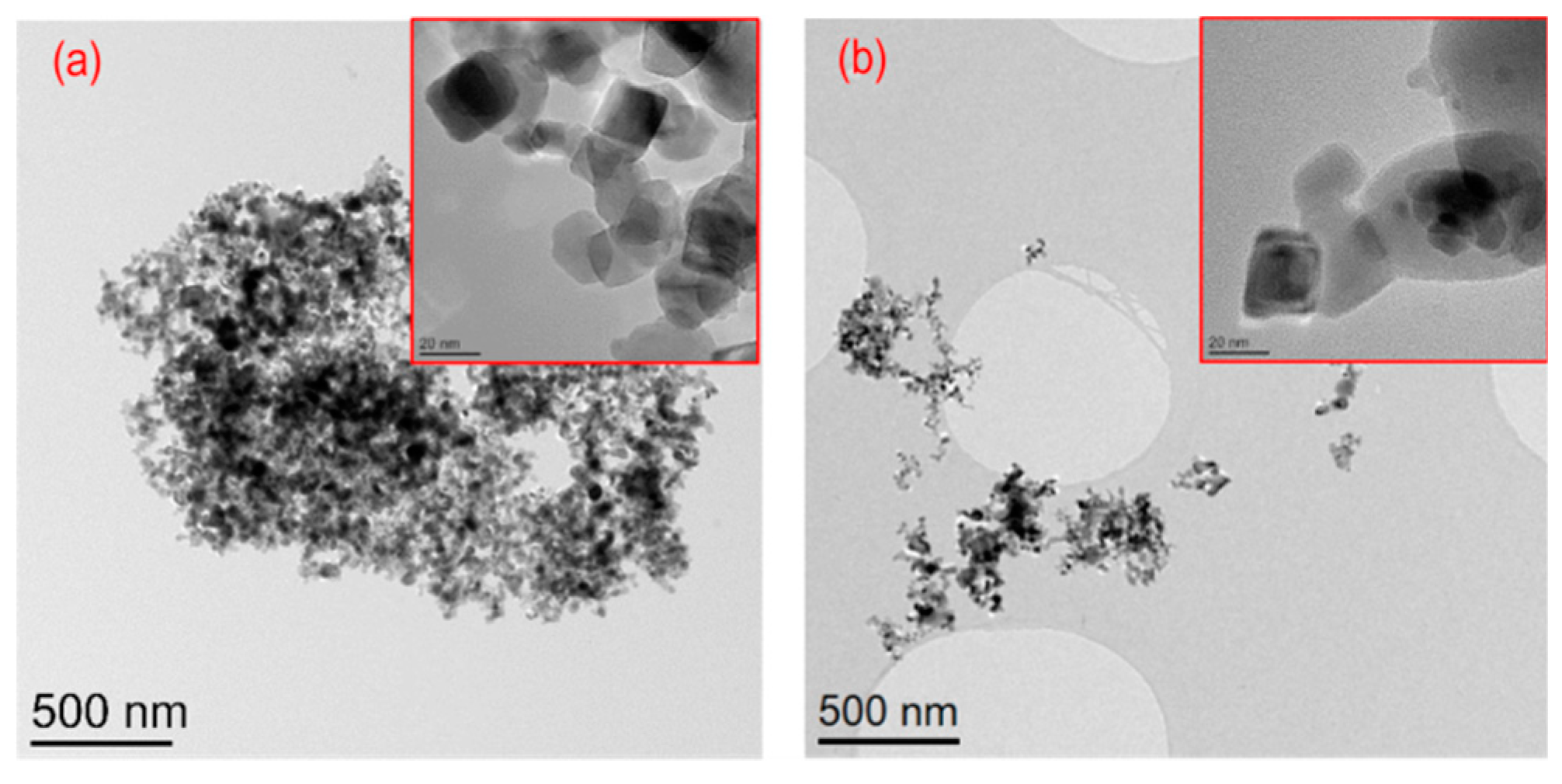

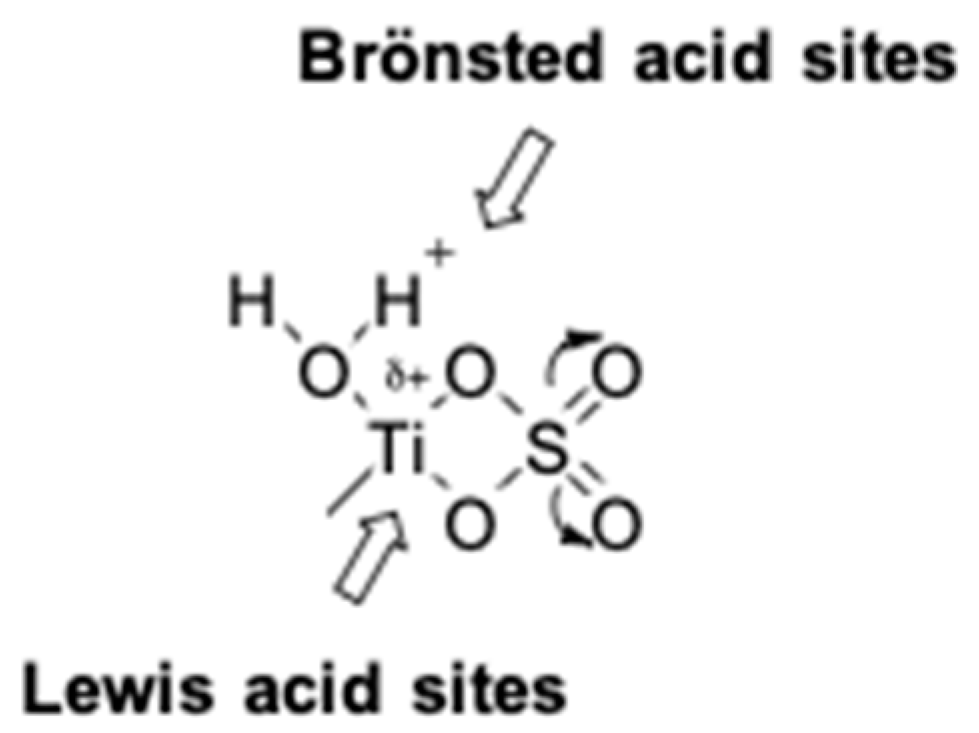


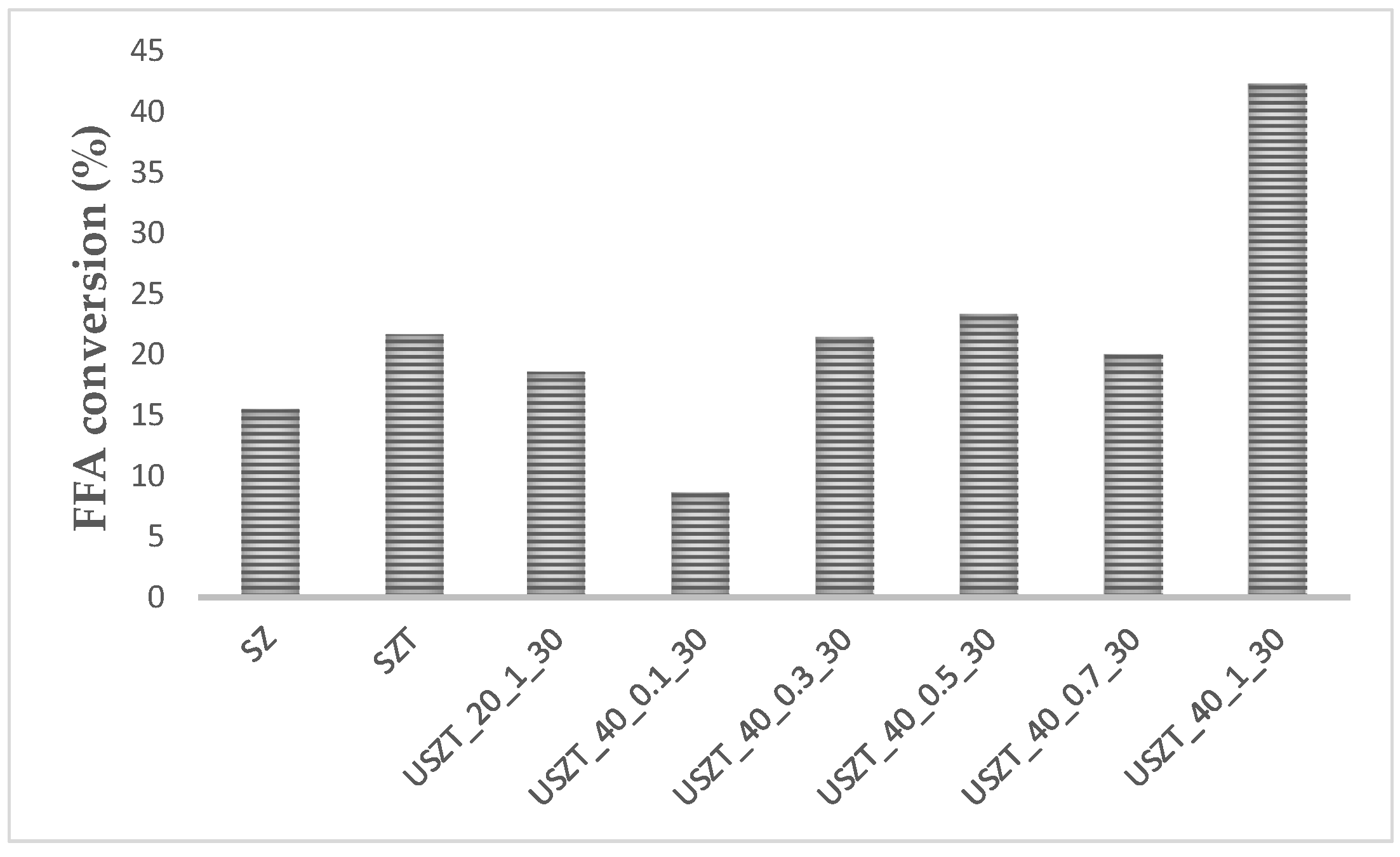
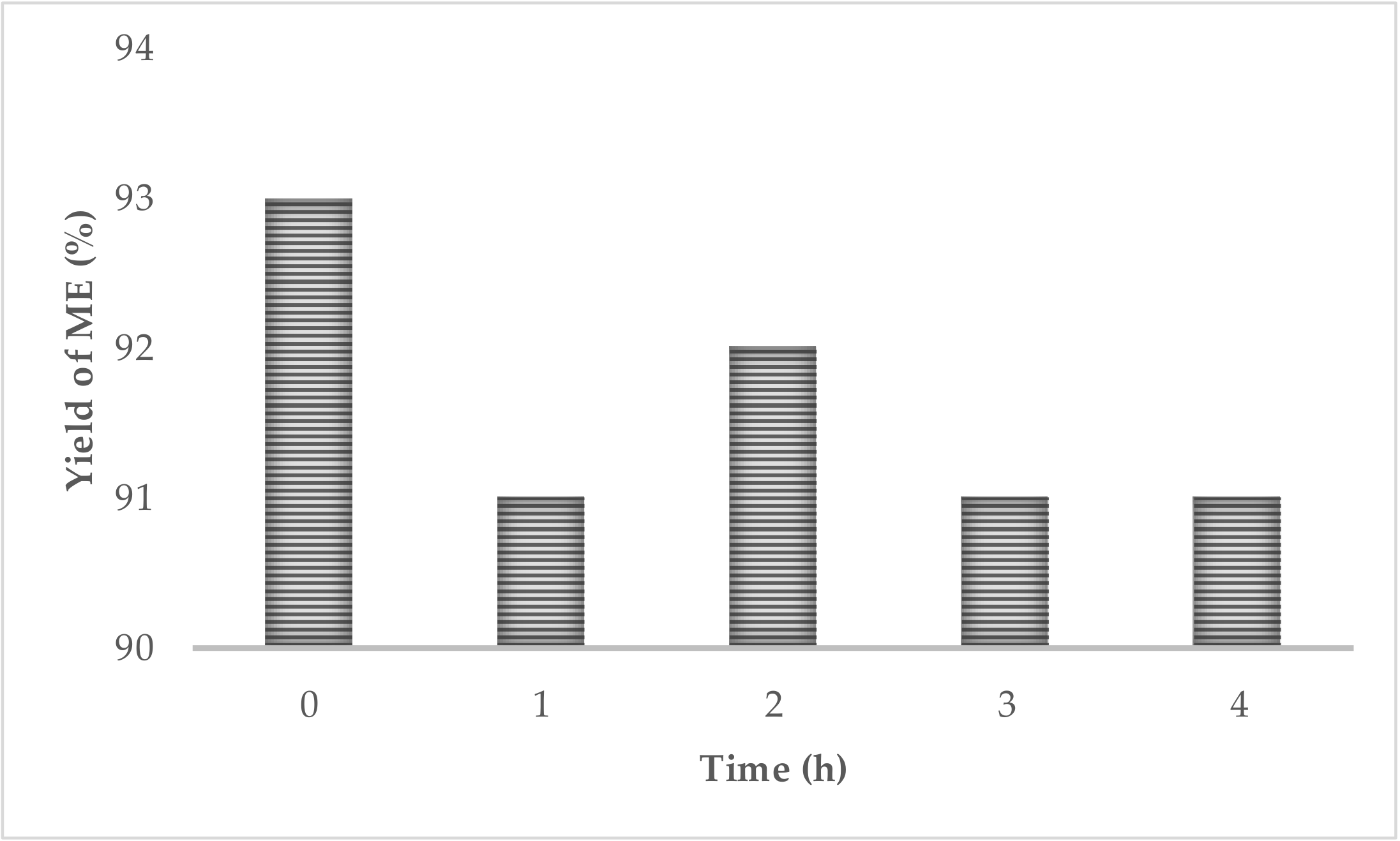
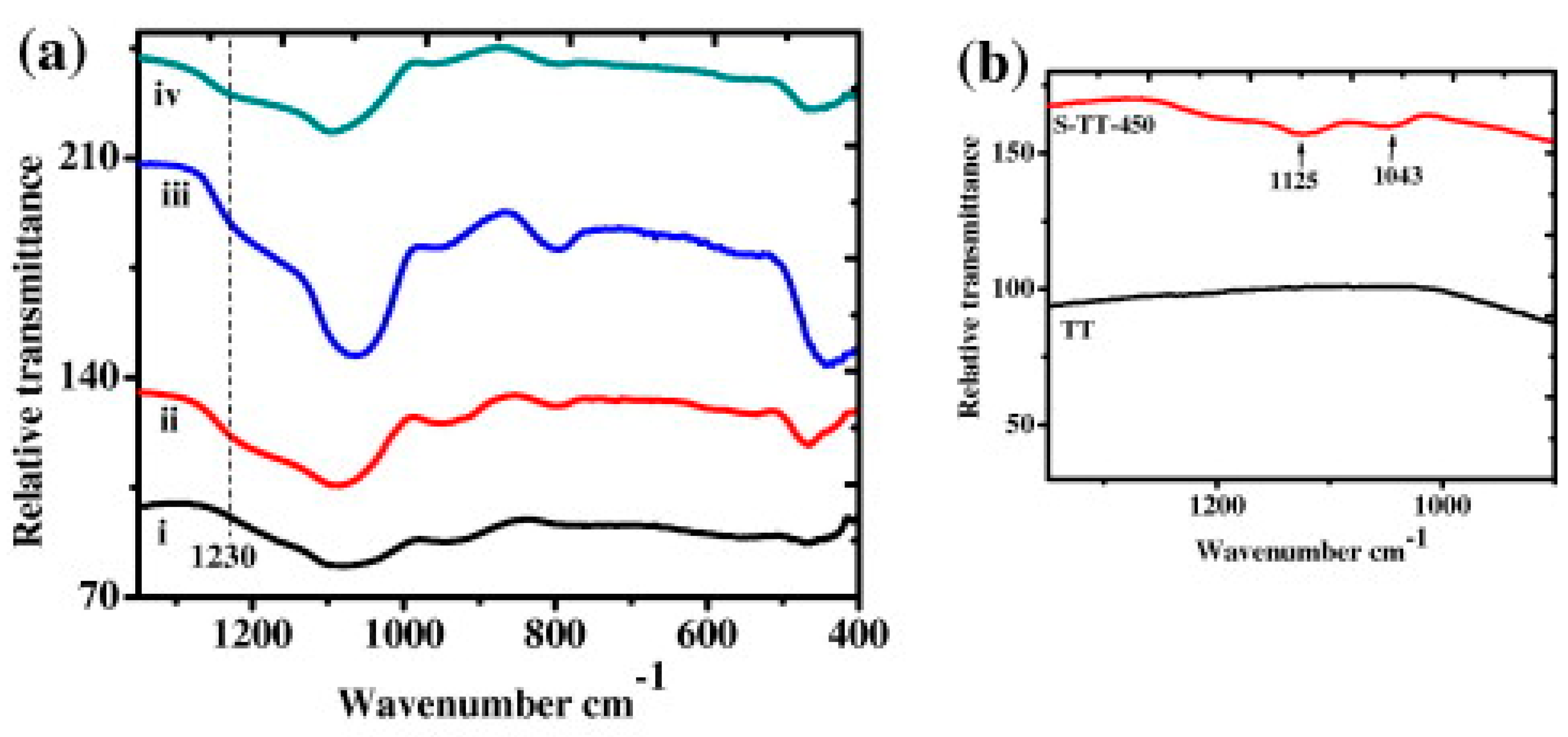


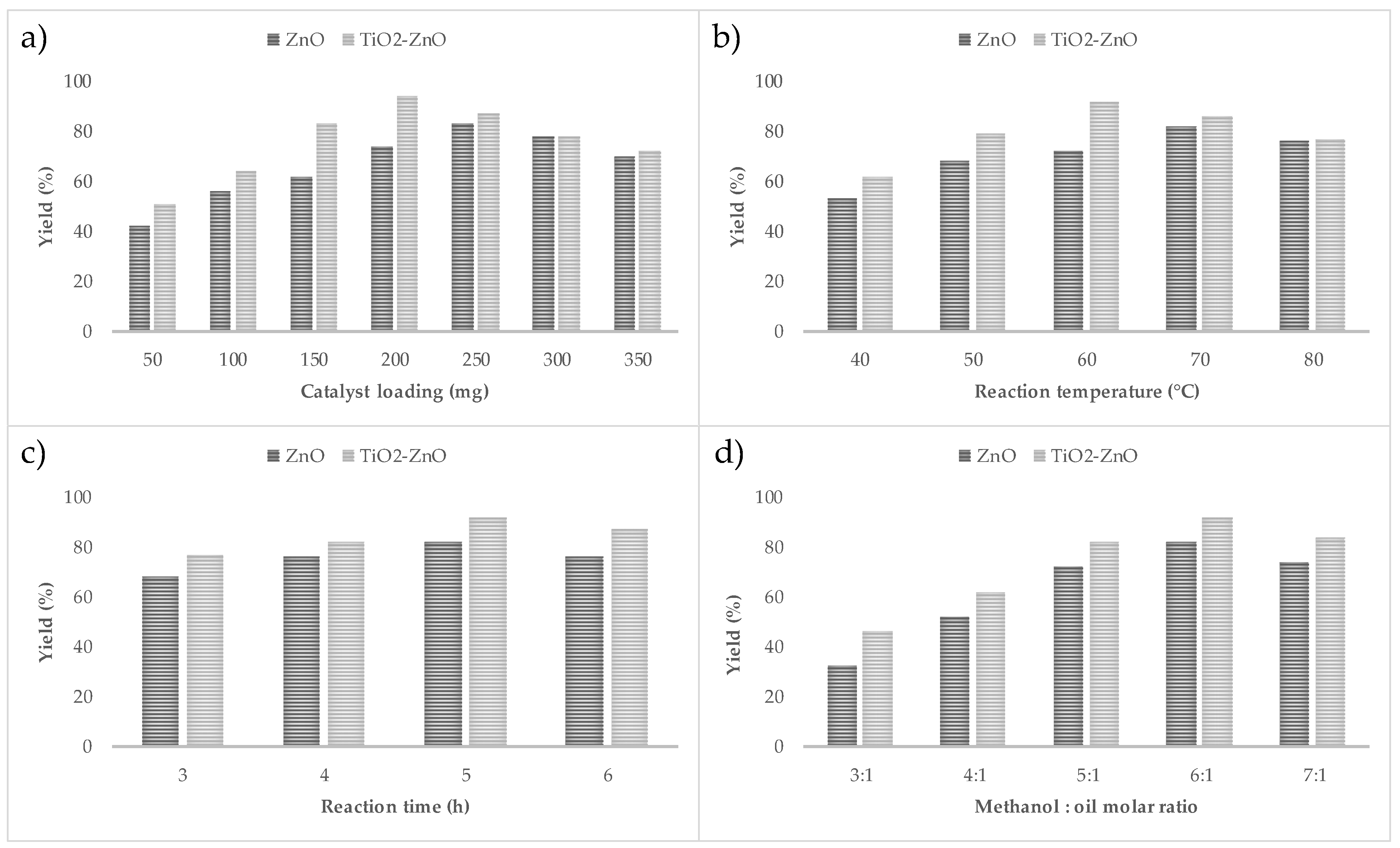


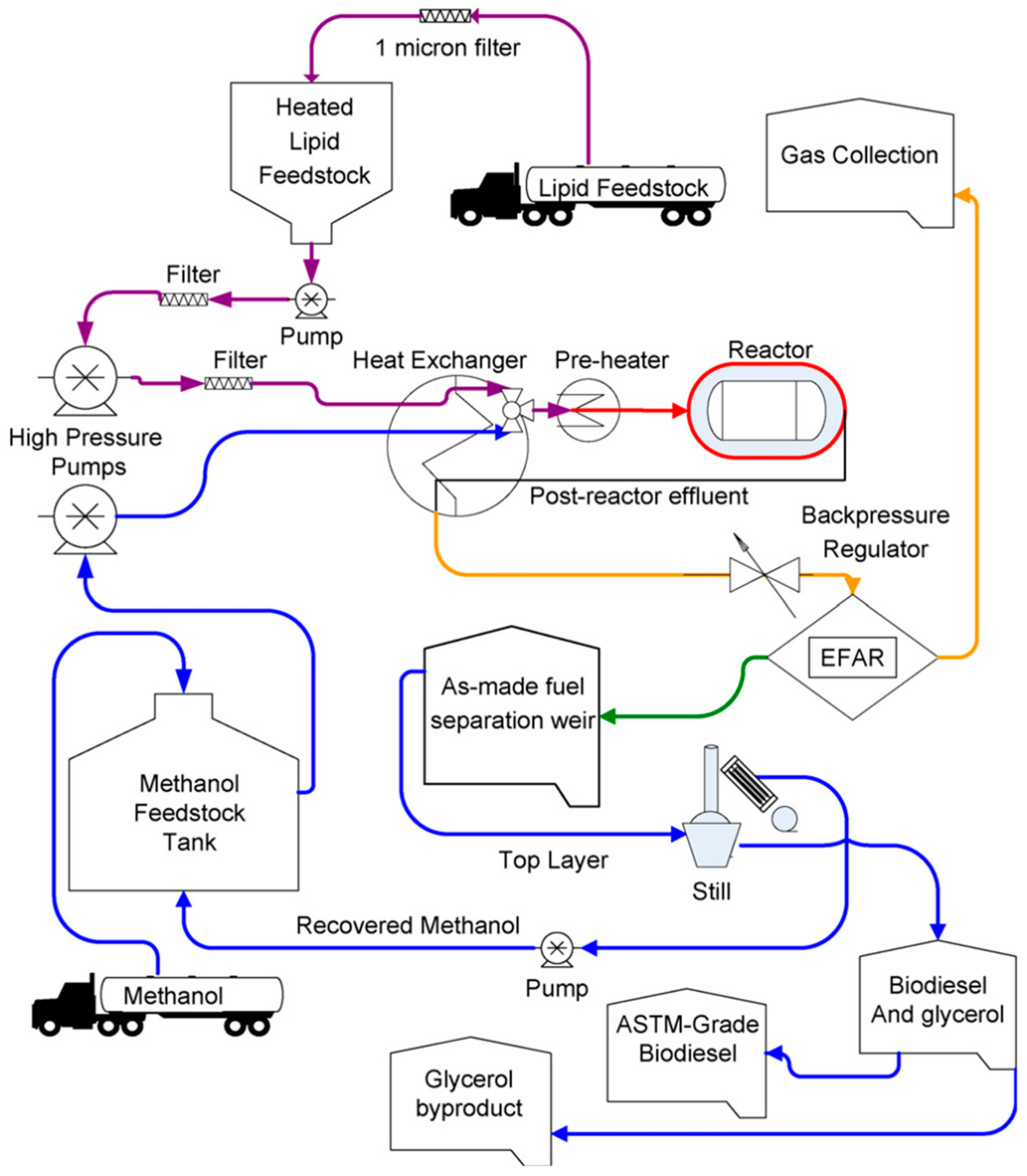





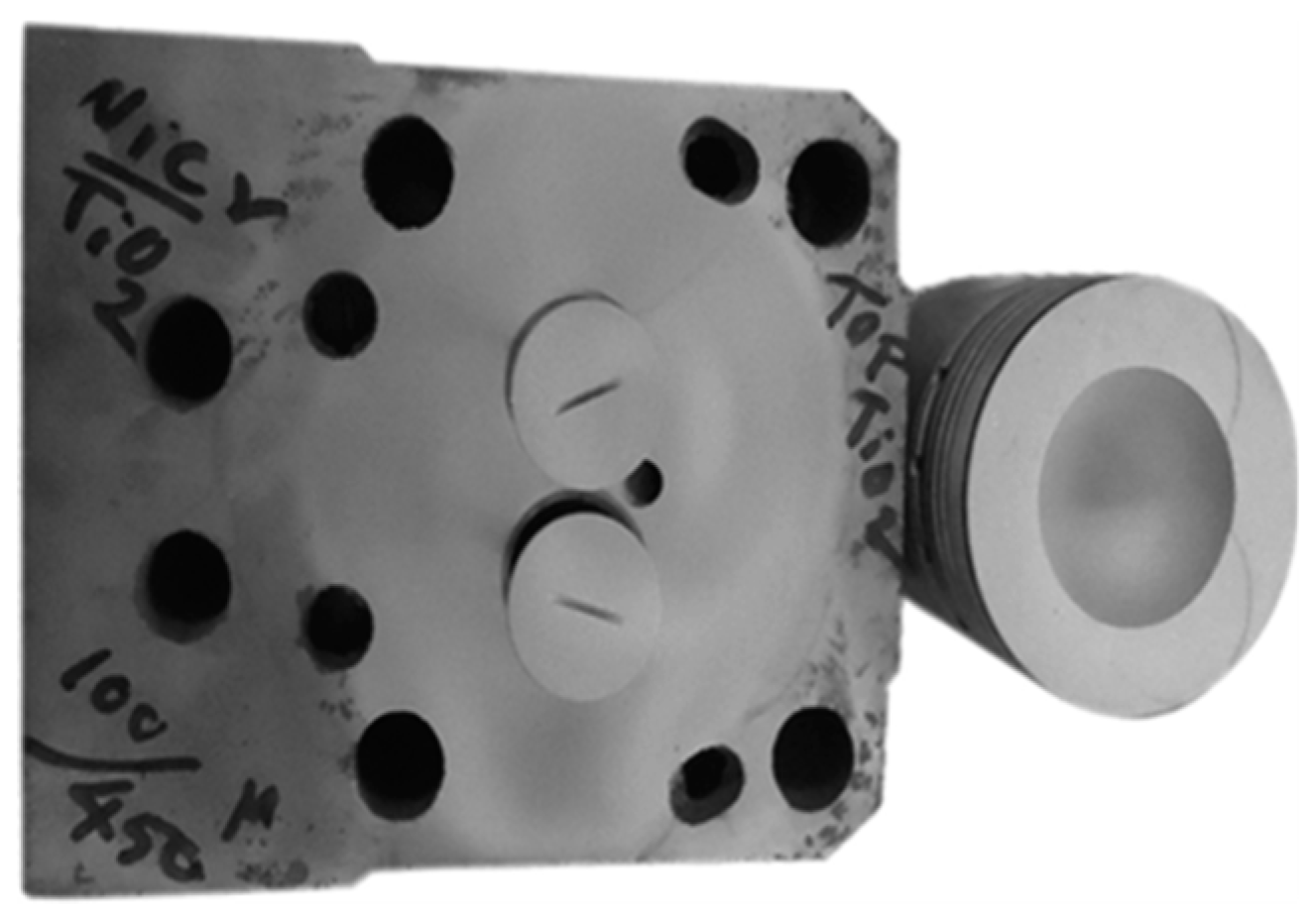
| Oleic acid to oil, wt.% | 0.5 | 1 | 2 | 3 | 4 | 5 | 5.5 | 6 | 6.5 | 7 |
| FAME yield% | 97.1 | 97 | 97.1 | 97.01 | 96.14 | 95.69 | 93.42 | 91.37 | 75.39 | 64.5 |
| Catalyst | 2-Propanol | Oleic Acid |
|---|---|---|
| [TiO2-HNO3] | 0 | 3.1 |
| [TiO2/SO42−-H2SO4-IS] | 0.5 | 2.1 |
| [TiO2/SO42−-(NH4)2SO4-IS] | 10.54 | 47.0 |
| [TiO2/SO42−-(NH4)2SO4-I] | 46.06 | 82.2 |
| Temperature (°C) | Triglycerides | Diglycerides | Monoglycerides | Methyl Esters |
|---|---|---|---|---|
| 200 | 4.7 | 4.8 | 4 | 86.5 |
| 210 | 3.2 | 3.7 | 3.1 | 90 |
| 220 | 2.3 | 2.5 | 2 | 93.2 |
| 230 | 1 | 1.8 | 1.2 | 96 |
| Time Reaction (h) | Catalyst Loading (wt.% Algae Oil) | Molar Ratio Algae Oil:Methanol | Acidity |
|---|---|---|---|
| 5 | 6 | 1.3 | 4.98 |
| 5 | 6 | 1.6 | 2.23 |
| 5 | 6 | 1.9 | 1.57 |
| 5 | 6 | 1.12 | 1.60 |
| 5 | 2 | 1.9 | 5.40 |
| 5 | 4 | 1.9 | 3.34 |
| 5 | 6 | 1.9 | 1.57 |
| 5 | 8 | 1.9 | 1.61 |
| 1 | 6 | 1.9 | 3.78 |
| 2 | 6 | 1.9 | 2.55 |
| 3 | 6 | 1.9 | 2.09 |
| 4 | 6 | 1.9 | 1.89 |
| 5 | 6 | 1.9 | 1.57 |
| 6 | 6 | 1.9 | 1.58 |
| Sample | Synthesis Time | Sonication Time | Acid Capacity (meq H+/g) | Specific Surface Area (m2 g−1) |
|---|---|---|---|---|
| SZ | 123′0′′ | 0′′ | 0.30 | 107 |
| SZT | 123′0′′ | 0′′ | 0.79 | 152 |
| SZT_773_6h | 123′0′′ | 0′′ | 0.21 | 131 |
| USZT_20_1_30 | 43′0′′ | 43′0′′ | 0.92 | 41.7 |
| USZT_40_0.1_30 | 43′0′′ | 4′18′′ | 1.03 | 47.9 |
| USZT_40_0.3_30 | 43′0′′ | 12′54′′ | 1.99 | 232 |
| USZT_40_0.5_7.5 | 17′30′′ | 8′45′′ | 1.70 | 210 |
| USZT_40_0.5_15 | 26′0′′ | 13′0′′ | 2.02 | 220 |
| USZT_40_0.5_30 | 43′0′′ | 21′30′′ | 2.17 | 153 |
| USZT_40_0.5_60 | 77′0′′ | 38′30′′ | 0.36 | 28.1 |
| USZT_40_0.7_30 | 43′0′′ | 30′6′′ | 1.86 | 151 |
| USZT_40_1_15 | 26′0′′ | 26′0′′ | 3.06 | 211 |
| USZT_40_1_30 | 43′0′′ | 43′0′′ | 1.56 | 44.1 |
| Catalyst 10% (wt) | Conversion % OA | Conversion % WO |
|---|---|---|
| H2SO4 | 91.6 | 94.7 |
| TSC-550 | 29.6 | 2.6 |
| S-TSC-450 | 93.7 | 77 |
| S-TSC-550 | 93.8 | 70.4 |
| S-TSC-650 | 37.3 | 12.2 |
| S-TSC-800 | 9.8 | Not active |
| S-TT-450 | 93.4 | 88.1 |
| Catalyst | RT1 a | RT2 b | RT3 c | RT4 d | RT5 e |
|---|---|---|---|---|---|
| SO42−/TiO2 (ST) | 73.3 | 57.1 | 39.5 | Trace | Trace |
| SO42−/TiO2-SiO2 (STS) | 80.1 | 78.6 | 75.0 | 70.8 | 61.6 |
| SO42−/TiO2/La3+ (STL) | 92.3 | 92.1 | 91. 7 | 91.1 | 90.2 |
| Catalyst | Reaction Cycles | ||||
|---|---|---|---|---|---|
| 1 (%) | 2 (%) | 3 (%) | 4 (%) | 5 (%) | |
| SO42−/TiO2-ZrO2/La3+ | 97.8 | 95.9 | 95.8 | 95.1 | 93.6 |
| SO42−/TiO2-ZrO2 | 86.9 | 82.5 | 80.7 | 73.1 | 65.2 |
| Sample | Soybean Oil Conv. (%) | Monoglyceride Fatty Acids (%) | Diglyceride (%) | Triglyceride (%) | Biodiesel (%) |
|---|---|---|---|---|---|
| FT-500 a | 23.6 | 4.20 | 16.6 | 76.4 | 2.80 |
| SFT-300 | 100 | 7.54 | 1.06 | Traces | 91.4 |
| SFT-500 | 98.3 | 5.11 | 1.01 | 1.68 | 92.2 |
| SFT-700 | 76.5 | 15.5 | 18.3 | 20.5 | 45.7 |
| SFT-900 | 65.7 | 11.3 | 24.2 | 34.3 | 30.2 |
| Methanol/Oil (Molar Ratio) | Catalyst Amount (wt.%) | Temperature (K) | Biodiesel Yield a (%) |
|---|---|---|---|
| 20 | 5 | 423 | 52 |
| 30 | 5 | 423 | 79.9 |
| 40 | 5 | 423 | 83.5 |
| 50 | 5 | 423 | 85.6 |
| 60 | 5 | 423 | 85.3 |
| 50 | 6 | 423 | 86.9 |
| 50 | 8 | 423 | 86.9 |
| 50 | 10 | 423 | 91.2 |
| 50 | 12 | 423 | 91.2 |
| 50 | 15 | 423 | 89.3 |
| 50 | 10 | 403 | 22.3 |
| 50 | 10 | 413 | 67.6 |
| 50 | 10 | 433 | 92.3 |
| 50 | 10 | 443 | 91.6 |
| Sample | Surface Area (m2/g) | Methyl Ester Yield (%) |
|---|---|---|
| CaTiO3 | 4.9 | 79 |
| CaMnO3 | 1.5 | 92 |
| Ca2Fe2O5 | 0.7 | 92 |
| CaZrO3 | 1.8 | 88 |
| CaCeO3 | 2.9 | 89 |
| BaZrO3 | 3.3 | 0.4 |
| BaCeO3 | 2.8 | - |
| MgZrO3 | 7.4 | 0.5 |
| MgCeO3 | 7.7 | 0.4 |
| Sample | NaTNT | NaK(10)TNT | NaK(20)TNT | NaK(30)TNT |
|---|---|---|---|---|
| Conversion to biodiesel (%) | 58.4 | 74.3 | 96.2 | 94.3 |
| Kinematic viscosity (mm2/s) | 7.8 | 6.0 | 4.3 | 4.5 |
| Oil Source | Catalyst | Reactor | Conditions | Yield % | Ref. |
|---|---|---|---|---|---|
| Waste | [Ti(SO4)O] | glass batch | 75 °C, 3 h, methanol/oil 9:1 catalyst 1.5 wt.% | 97.1 | [15] |
| Acetic acid,n-butanol | TiO2-SO42− | flask | 120 °C, 150 min methanol/oil 1.2 catalyst 1.8 g | 92.2 | [17] |
| Oleic | [TiO2/SO42-(NH4)2SO4] [TiO2/SO42-H2SO4] [TiO2/SO42-(NH4)2SO4-IS] | reflux condenser | 80 °C, 3 h methanol/oil 10:1 catalyst 2 wt.% | 82.2 | [18] |
| Rapeseed | TiO2-SO42− | flask | 353 K, 6–12 h, methanol/oil 12:1 catalyst 1.2 g | 51 | [19] |
| Soybean Castor | TiO2/SO42− | stainless steel batch | 120 °C, 1 h methanol/oil/catalyst 120:20:1 | 40 25 | [20] |
| Cottonseed | TiO2-SO42− | autoclave | 230 °C, 8 h methanol/oil 12:1 catalyst 2 wt.% | 90 | [21] |
| Microalgae | SO42−/TiO2-ZrO2 | flask | 5 h, methanol/oil 9:1 catalyst 6 wt.% | 96 | [22] |
| Rapeseed | SO42−/80%ZrO2-20%TiO2 | oil bath | 6 h at 336 ± 2 K, methanol/oil 4.5:1 catalyst 5 wt.% | 42.4 | [23] |
| Waste | SO42−/TiO2-SiO2 | autoclave | 200 °C, methanol/oil 9:1 catalyst 3 wt.% | 92 | [24] |
| Waste Oleic acid | TiO2-SiO2 SO42−/TiO2-SiO2 | autoclave | 120 °C, 3 h methanol/oil 20:1 catalyst 10 wt.% | 94.7 93.8 | [25] |
| Waste | SO42−/TiO2-SiO2 | reaction flask | 120 °C, 5 h methanol/oil 15:1 catalyst 13 wt.% | 91 | [26] |
| Waste | SO42−/TiO2/La3+ | autoclave | 110 °C, 1 h methanol/oil 10:1 catalyst 5 wt.% | 96.16 | [27] |
| Rapeseed | SO42−/ZrO2-TiO2/La3+ | flask | 60 °C, 5 h 5 wt.%, methanol 1 mL/g fatty acid (FA) | 95 | [28] |
| Soybean | sulfated Fe2O3/TiO2 | autoclave | 100 °C, 2 h, methanol/oil 20:1 catalyst 15 wt.% | 92.2 | [29] |
| Waste | TiO2-ZnO | pressurized reactor | 200 °C, 1 h, methanol/oil 18:1 catalyst 10 wt.% | 82.1 | [30] |
| Palm | TiO2-ZnO | flask | 60 °C, 5 h methanol/oil 6:1 catalyst 200 mg | 98 | [31] |
| Waste | TiO2-MgO | stainless steel batch | 225 °C, 1 h methanol/oil 18:1 catalyst 20 wt.% | 100 | [32] |
| Soybean | Nano-MgO TiO2 | stainless steel batch | 225 °C, 1 h methanol/oil 18:1 catalyst 5 wt.% | 84 | [33] |
| Waste | TiO2-MgO | stainless steel batch | 423 K, 6 h, methanol/oil 30:1 catalyst 5 wt.% | 92.3 | [34] |
| Rapeseed | CaTiO3 | flask | 60 °C, 10 h methanol/oil 6:1 | 90 | [35] |
| Canola | K/TiNT K/TiO2 | glass batch | 70 °C, 5 h methanol/oil 36:1 catalyst 20 wt.% | 100 | [36] |
| Canola | K/TiHT | glass batch | 55 °C, 3 h methanol/oil 54:1 catalyst 20 wt.% | >90 | [37] |
| Soybean | NaK(20)TNT | stainless steel batch | 80 °C, 1 h NaOH/KOH 7:3 catalyst 3.2 wt.% | 96.2 | [38] |
| Temperature (°C) | LHSV (h−1) | Liquid Crude (vol.%) | Gaseous Product (per L of Feed) | Distilled Biofuel (vol.%) | Condensed Water (vol.%) | ||||||||||
|---|---|---|---|---|---|---|---|---|---|---|---|---|---|---|---|
| 340 | 1.12 | 1.87 | 2.25 | 77 | 80 | 84 | 85 | 88 | 76 | 57 | 55 | 58 | 1.5 | 0.9 | 1.3 |
| 380 | 1.12 | 1.87 | 2.25 | 79 | 85 | 87 | 90 | 78 | 95 | 55 | 59 | 51 | 2.1 | 1.6 | 1 |
| 420 | 1.12 | 1.87 | 2.25 | 75 | 77 | 80 | 102 | 98 | 105 | 52 | 54 | 50 | 1.1 | 0.7 | 0.9 |
| Catalyst | BMT | BMT | BMT | UMT | None |
|---|---|---|---|---|---|
| Reactor volume (mL) | 23.55 | 23.55 | 23.55 | 23.55 | 2.49 |
| Preheater T (°C) | 363 | 370 | 340 | 350 | 455 |
| Column inlet T (°C) | 348 | 359 | 343 | 353 | 445 |
| Column outlet T (°C) | 339 | 325 | 344 | 355 | 462 |
| Initial T (°C) | 209 | 184 | 247 | 247 | 203 |
| Final T (°C) | 94 | 63 | 76 | 76 | 57 |
| Initial P (psi) | 3.65 | 3.1 | 2.5 | 2.5 | 3.05 |
| Final P (psi) | 2.7 | 2.7 | 2.3 | 2.3 | 2.7 |
| Molar ratio (alcohol/oil) | 32.7 | 32.7 | 32.7 | 50.0 | 32.7 |
| Total flow rate (mL/min) | 15.904 | 15.904 | 15.904 | 15.904 | 17.808 |
| Residence time (s) | 56.9 | 56.9 | 56.9 | 56.9 | 5.4 |
| Mcgyan Process | Homogeneous Process | |
|---|---|---|
| Consume of the catalyst | No | Yes |
| Large amounts of H2O | No | Yes |
| Waste products | No | Yes |
| Soap byproducts | No | Yes |
| Glycerol as byproduct | No | Yes |
| Large footprint | No | Yes |
| Sensitive to H2O | No | Yes |
| Sensitive to FFA | No | Yes |
| Large quantities of strong acid/base | No | Yes |
| Conversion rate | Sec | h/d |
| Variety of feedstocks | Yes | No |
| Continuous process | Yes | No |
| Temperature (°C) | Conversion (%) | Total PO | 1-PO a | 2-PO b | 1,2-PD | 1,3-PD | Acrolein | Others c |
|---|---|---|---|---|---|---|---|---|
| 180 | 70 | 74 | 59 | 15 | 9.0 | 3.2 | 9.3 | 4.5 |
| 200 | 82 | 80 | 67 | 13 | 5.4 | 2.2 | 8.7 | 3.7 |
| 220 | 100 | 97 | 87 | 10 | – | – | 02 | 01 |
| 240 | 100 | 88 | 80 | 08 | – | – | 4.2 | 7.8 |
| 260 | 100 | 84 | 76 | 08 | – | – | 01 | 15 |
| Time (h) | Glycerol (%) | Acrolein (%) | Hydroxyacetone (%) | Acetaldehyde (%) | Propionaldehyde (%) |
|---|---|---|---|---|---|
| 1 | 97 | 40 | 1.1 | 1.7 | 7.2 |
| 2 | 98 | 61 | 1.1 | 1.9 | 1.1 |
| 3 | 97 | 82 | 1.9 | 1.3 | 0.5 |
| 4 | 93 | 84 | 1.6 | 1.5 | 0.6 |
| 5 | 95 | 81 | 2.2 | 1.2 | 0.5 |
| Average | 96 | 70 | 1.6 | 1.5 | 2.0 |
| Oil Sources | Catalyst | Reactor | Condition | Ref |
|---|---|---|---|---|
| Jatropha | Alumino-Silicate TiO2 | fixed bed | 340 and 420 °C LHSV (1.12, 1.87, 2.25 h−1) | [46] |
| Soybean, tall, algae, acid soapstock,corn | TiO2 | fixed bed | 2500 psi, 300–450 °C residence time 5.4 s | [47] |
| Dunaliella tertiolecta, Nannochloropsis oculata | TiO2 | fixed bed | 2500 psi, 340 °C residence time 30 s | [48] |
| Palm | TiO2/Al2O3 | packed membrane | 70 °C, 1.12 wt.% 0.211 cm s−1 | [49] |
| Source | Catalyst | Reactor | Condition | Ref |
| Glycerol | WO3/TiO2 | plug flow fixed-bed | 280 °C, WO3/TiO2 15 wt.% glycerol flow rate 23 g/h O2 flow 11.33 mL/min | [52] |
© 2019 by the authors. Licensee MDPI, Basel, Switzerland. This article is an open access article distributed under the terms and conditions of the Creative Commons Attribution (CC BY) license (http://creativecommons.org/licenses/by/4.0/).
Share and Cite
Carlucci, C.; Degennaro, L.; Luisi, R. Titanium Dioxide as a Catalyst in Biodiesel Production. Catalysts 2019, 9, 75. https://doi.org/10.3390/catal9010075
Carlucci C, Degennaro L, Luisi R. Titanium Dioxide as a Catalyst in Biodiesel Production. Catalysts. 2019; 9(1):75. https://doi.org/10.3390/catal9010075
Chicago/Turabian StyleCarlucci, Claudia, Leonardo Degennaro, and Renzo Luisi. 2019. "Titanium Dioxide as a Catalyst in Biodiesel Production" Catalysts 9, no. 1: 75. https://doi.org/10.3390/catal9010075
APA StyleCarlucci, C., Degennaro, L., & Luisi, R. (2019). Titanium Dioxide as a Catalyst in Biodiesel Production. Catalysts, 9(1), 75. https://doi.org/10.3390/catal9010075






